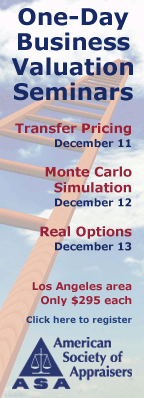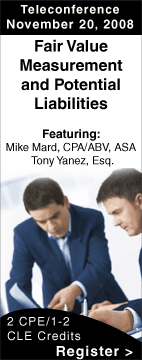
| SPECIAL ASA/AICPA CONFERENCE ISSUE “I want to take you through the ten layers of hell,” Professor Aswath Damodaran of NYU Leonard N. Stern School of Business told a rapt general session on day two of the AICPA/ASA joint BV conference in Las Vegas.
Professor Damodaran routinely posts his presentations at his website; a must-see for all BV experts. This one—with its extensive illustrations of the DCF inferno into which some analysts can fall, promises to be one of the more provocative. Will Frazier, ASA of Howard Frazier Barker Elliot, Inc. spoke about the Non-marketable Investment Company Evaluation Method (NICE) at the ASA/AICPA National Business Valuation Conference in Las Vegas this week. NICE is used when determining the fair market value of equity interests in closely held investment entities like Family Limited Partnerships (FLPs), that hold a portfolio of assets in long term investments. “All the action in the Tax Court is with Discount for Lack of Marketability (DLOM). NICE bypasses the DLOM “action” by focusing on the rates of return of the various assets held,” Frazier told a packed house in Las Vegas. NICE is based on Modern Portfolio Theory where there are observable sources of information, risks and rewards are investigated, assets are allocated and the expected holding periods are considered. NICE “doesn’t drop you in the ocean and hope you can swim—it gives you a lifeboat and a compass.” NICE is a tool that helps the appraiser find the value at which the rate of return satisfies the objectives of both the seller and buyer – thereby determining fair market value. Frazier’s goal is to have NICE available as a commercially available web-based tool by the end of next spring, at the latest. The BVWire™ will keep readers in the know about its availability. More on Non-marketable Investment Company Evaluation (NICE) The new 2009 Edition of BVR's Guide to Business Valuation Issues in Estate and Gift Tax includes new court case abstracts from the past year, including in-depth analysis on the Astleford, Bigelow, Holman, and Jelke decisions. Several new articles exclusive to the Guide have also been added, including Will Frazier’s Non-Marketable Investment Company Evaluation (NICE) method and Owen Fiore’s overview of the impact of the before mentioned court decisions, as well as a list of success factors for creating FLPs/LLCs, which were discussed in the #72-1 BVWire™. Assessing the impact of SSVS No. 1 Robert Reilly, ASA, CPA/ABV, CM&A of Willamette Management Associates moderated a panel that included several BV heavy hitters in Las Vegas this week. Those of you who missed this ASA/AICPA presentation (the event drew some 1400 attendees) missed an informative and spirited discussion about the impact of SSVS No. 1 and what BV practitioners are seeing in various regions across the U.S. One of those discussions pertained to calculations versus opinions and how courts in different parts of the U.S. are interpreting them – some determine a calculation to be an opinion and some throw a calculation out as an opinion. One of the others offered insights about when an appraiser is required to adhere to the new standards, and when they’re not. Consider: If appraiser A is looking at an opposing expert’s report and determines that report contains an error – if appraiser a makes a correction to that report, do they have to follow SSVS No. 1? The answer? No, because the correction was not appraiser A’s opinion, but rather the correction of an error and the recalculated value based on that correction. But if appraiser A is asked their opinion about the opposing expert’s report, then the appraiser is expressing their opinion and the appraiser must follow SSVS No. 1. Is this semantics? It may be, but the panel of experts believed there was a bright yellow line distinguishing these two situations. In the first situation, appraiser A is fixing the multiple or fixing a formula or data point, but they didn’t pick the guideline companies, the methodology, or anything else—so they’re not expressing their opinion. If their opinion is requested in court, one expert suggested a response something like “Give me a couple of weeks and more money and I can give you my opinion.” The bright yellow line is differentiated by “I’m correcting the opposing expert’s mistakes” versus “I’m using my own judgment, approaches and procedures.” Look for more on the AICPA’s SSVS No. 1 and how it compares to the standards from other professional organizations and USPAP in an article penned by David Anderson, ASA of Amper Politziner & Mattia and Donald Wisehart, ASA, CPA/ABV, CVA, of Wisehart Inc., a North Kingstown, Rhode Island-based CPA firm, in the upcoming December issue of the Business Valuation Update™ newsletter. It will include a comprehensive comparison comparative table of all standards. Has the current financial meltdown affected early stage valuations? |
|
To ensure this email is delivered to your inbox,
please add editor@bvwire.com to your e-mail address book.
We respect your online time and privacy and pledge not to abuse this medium. To unsubscribe to BVWire™ reply to this e-mail with 'REMOVE BVWire' in the subject line or click here.
Copyright © 2008 by Business Valuation Resources, LLC
BVWire™ (ISSN 1933-9364) is published weekly by Business Valuation Resources, LLC
Editorial Staff | Advertise in the BVWire | Copyright Notice
|
|



